|
Blue Willow Pattern Advertising
by Hugh Sykes
Posted February 2016

|
My first conscious introduction to the Blue Willow Pattern came in 1993 when in Sydney, Australia, I met my wife Kathy. At that time, she had been collecting all things Blue Willow for quite a while. Fast forward to 1999; that was the year we travelled to Richmond, Virginia, for an annual convention hosted by the International Willow Collectors. While most of us are familiar with the traditional Blue Willow Pattern seen on ceramic china, that convention opened up our eyes, showing us how the Blue Willow Pattern was not just blue but came in a multitude of colors and was not just a pattern seen on ceramic china. After the Richmond convention, I decided to start collecting Blue Willow Pattern, not just the regular blue and white, but pieces that had an advertising theme or interest.
The legend of the Blue Willow Pattern and the design we see on blue and white china everywhere today was designed by the English pottery of Minton, circa 1780, in order to add a touch of Oriental magic to cheaper earthenware and make it more attractive and therefore more saleable. The design was printed on a transfer that was applied to the pottery before firing, allowing for the quite cheap production of elaborate designs. At the time, Chinese designs were all the rage in Britain, but the remarkable thing is the popularity of the Blue Willow Pattern has never really waned. Over the years, the Blue Willow Pattern has become perhaps the most recognized pattern in the world, a pattern that has a legend, history and universal acceptance.
|
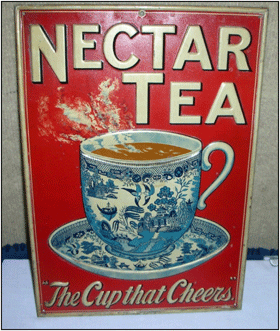
|
Enamel sign from the 1950s using the Blue Willow pattern to advertise Nectar Tea.
|
It is qualities like these that advertisers and marketing departments like to associate their products and services with. Therefore, it is no surprise that the "Willow Pattern brand" has over the past 200 years been used to promote a vast array of products and services. The pattern has been associated with airlines, beverages, chocolates, cigarettes, souvenirs and restaurants, to name a few. Although the Blue Willow Pattern has a strong English heritage, it is perhaps more widely known and used in the United States where it is affectionately known as AmericaтАЩs favorite pattern.
As a collector of Blue Willow Pattern that has been used for advertising, I can say that I have more than 500 examples of thisтАФtoo many to show for this article. What I have therefore done is chosen six American examples which have an interesting story behind them.
The first piece I have chosen is a plate which, on a cursory glance, displays a typical Blue Willow Pattern on it. On closer inspection though, you will see the words тАЬSherwood InnтАЭ under the Pagoda. Built as a stagecoach stop in 1807, the Sherwood Inn is located in the historic village of Skaneateles, New York, and has been a favorite resting place for travelers and locals for over two centuries. This modern-day piece made in 2000 by the Syracuse China Company, New York, was purchased in Jackson, Tennessee.
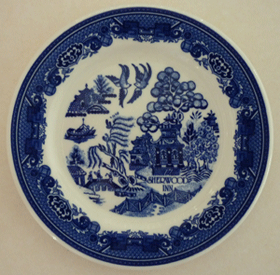
Sometimes the advertising component of a piece is not clearly evident. This platter even without the advertising theme is a special piece, firstly in that the china is pink and secondly the Blue Willow Pattern has departed from its traditional blue color to one where it is now multi-colored. On the reverse of the platter are the words тАЬCompliments of J. Ziobro Meats and Groceries 1158 Sycamore Street, Camden, NJ.тАЭ The platter would have been used as a gift for valued clients or for them to borrow. My research indicates that the business was trading during the 1930s and тАЬJтАЭ was short for John.
An iconic American brand, Blue Plate of New Orleans incorporated a Blue Willow Pattern plate to market its Blue Plate name. The history of the Blue Plate brand is extensive and originates from America's dining car history. Dining car restaurants would advertise a "Blue Plate" special where they would use a partitioned grill plate to provide a three-course meal at a set, and often inexpensive, price. While the Blue Plate brand has disappeared, Blue Plate Real Mayonnaise showing the Blue Plate logo can still be purchased in southern states. Here are two Blue Plate products that were produced in the 1970s.
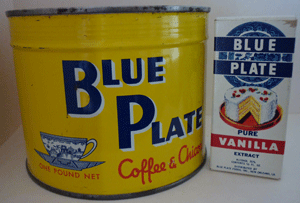
For many of us, it has been a tradition that when we go on holiday and visit a place that holds a special memory, we will quite often buy a souvenir. Sometimes, the souvenir might have a practical use or just be a display item. Over the years, the Blue Willow Pattern has been used extensively by numerous towns, cities and places of interest to create a souvenir. These souvenirs are usually a plate or a cup and saucer where, in addition to having the Blue Willow Pattern, are added the words тАЬGift fromтАжтАЭ or тАЬGreetings from.тАЭ Lots of these types of souvenirs have been produced for British seaside towns and other places of interest, and also many have been produced for notable places in the USA. An interesting souvenir piece made in Japan is an ashtray showing San Francisco and the Golden Gate Bridge.
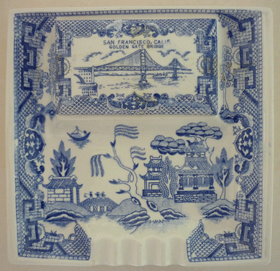
While we normally associate advertising with large business concerns, many small business operators have used the Blue Willow Pattern to advertise their businesses. This piece is a luster ware plate which has a multi-colored variation of the Blue Willow Pattern. The plate carries the words тАЬC Krejsa For Furniture.тАЭ My research suggests that the тАЬCтАЭ is an initial for Charles, who as Charles Krejsa, was born in 1886 and died in 1968. During his life, he operated a furniture store under his own name at 5203 Fleet Avenue in Cleveland, Ohio. I have sighted records showing that the business was operating in 1933, but I have been unable to confirm when it was established (or closed). This plate would have probably been a giveaway to business patrons, and my estimation is that this plate was probably produced in the 1930s.
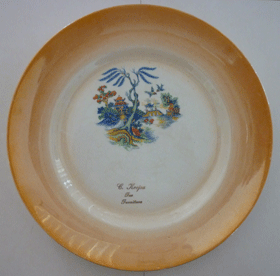
During the holidays, many businesses send their clients, patrons and suppliers Christmas cards. Pictured here is a Christmas greeting card featuring a Blue Willow Pattern plate along with a toby jug. The message in the card reads, тАЬThe same old greeting sent in the same happy remembrance as former years. Merry Christmas Bright New Year. Management and Staff, Stevens House, Lancaster. PA. (USA).тАЭ Stevens House, built in the 1800s and named after local congressman Thaddeus Stevens, was once regarded as one of the finest hotels in the State of Pennsylvania. Since closure and in recent times, the building has been converted to apartments.
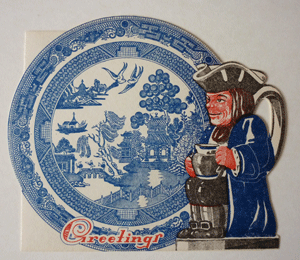
In this article I have touched briefly on some of the goods and services that have associated themselves with the Blue Willow Pattern. There are many more; some of which are current today include banks, telephone companies and accounting firms. Historically, some of the big brands which we are familiar with have used the Blue Willow Pattern; these include Schweppes, Sears, MacyтАЩs, CampbellтАЩs Soup Company and LiptonтАЩs, to name a few. Being AmericaтАЩs favorite pattern, I am sure the Blue Willow Pattern will continue to be seen in all manner of advertisements.
-------------------------------
|

|
Hugh Sykes is a past president of the International Willow Collectors and has written and published two books on the Blue Willow Pattern aptly titled, Advertising A To Z Featuring The Blue Willow Pattern (Parts 1 & 2). In addition to being a great read, both books are also academic and are held by several universities. They are also part of American history and are held at the Smithsonian Library, National Museum of American History. The curator of the Smithsonian Library quoted: тАЬThese works should prove useful for our support of the History of Decorative Arts MasterтАЩs Program, jointly run by the Smithsonian and George Mason University.тАЭ This bodes well for the future use of the Blue Willow Pattern. For further information about the books, visit www.redwillow3.wix.com/book
The International Willow Collectors Club has been around for 30 years and has members from the USA, New Zealand, Canada, England and Australia. The IWC holds a convention every year тАУ usually the first Thursday, Friday, Saturday and Sunday after 4th July. In 2016, it will be held in Springfield, Ill.; in 2017, it will be held in Atlanta, Ga., followed by Nashville, Tenn., in 2018. For further information about the IWC or conventions, visit www.willowcollectors.org
|
|